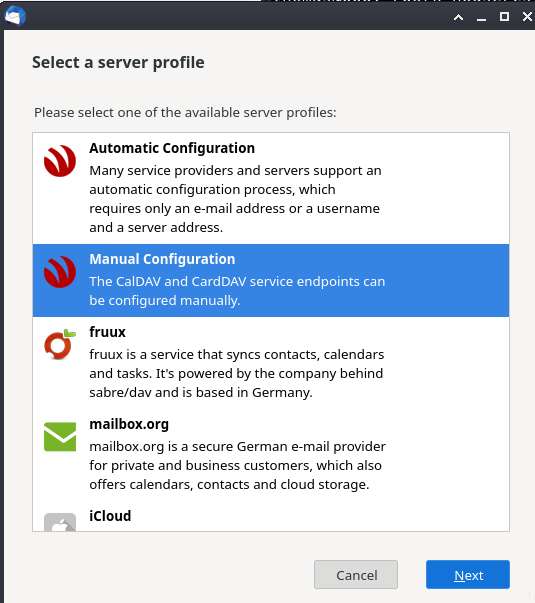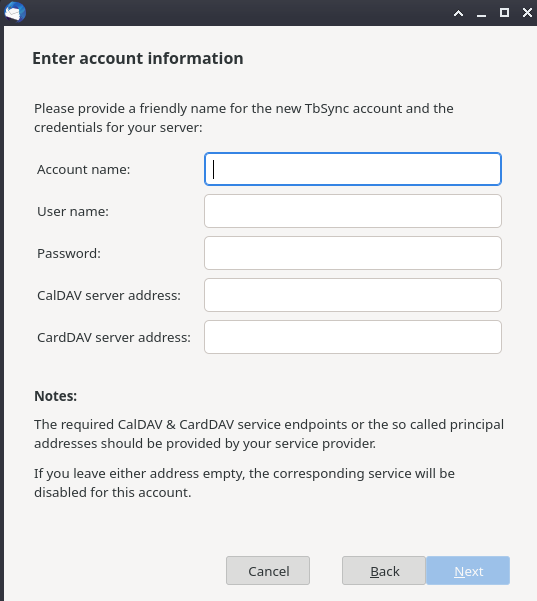CardDAV Sync
第一次使用 CardDAV 用來同步聯絡人,以 Xandikos 作為伺服器,用 vdirsyncer 進行主要同步,再配合 Thunder bird Tbsync 套件,堪稱完美。
Xandikos
Xandikos 是一個輕量級但完整的 CalDAV 和 CardDAV 伺服器。
安裝;
apt install xandikos第一次啟動
xandikos --defaults --autocreate -d $HOME/dav -p 8888即可馬上進行測試與驗證,如果覺得不錯,想要持續使用,可以放到systemd user mode ; 因為 目前 xandikos Multi user 沒有很好用。
設定 systemd user mode 自動啟動:
mkdir .config/systemd/user/xandikos.service xandikos.service
[Unit]
Description=Xandikos CalDAV/CardDAV server
After=network.target
[Service]
ExecStart=/usr/bin/xandikos \
--directory $YOUR/DAV/PATH//dav \
--listen-address 127.0.0.1 \
--route-prefix=/dav \
--port 8888 \
--defaults
Restart=on-failure
KillSignal=SIGQUIT
Type=simple
NotifyAccess=all
[Install]
WantedBy=multi-user.target
systemctl --user daemon-reload
systemctl --user restart xandikos.service同時有一個建議設定,因為系統已經有 apache2, 所以順便設定 recerse proxy
<Location "/dav/">
ProxyPreserveHost On
ProxyPass http://127.0.0.1:8888/dav/
ProxyPassReverse http://127.0.0.1:8888/dav/
AuthType Basic
AuthName DAV-Z
AuthUserFile /xxxx/.htpasswd
Require valid-user
</Location> 如此一來,我的DAV服務就是 https://xxx.thomas.org/dav/ 就會由 xandikos 進行。
也可以直接指定特並addressbook, 例如https://xxx.thomas.org/dav/user/contacts/addressbook/
csv2vcf
我有固定去爬一些通訊錄檔成 csv 檔案,這時候要用 csv2vcf,but vsf 3.0 thunderbird 不適應,所以魔改了一些
def convert_to_vcard(input_file, single_output, input_file_format):
FN = input_file_format['name']-1 if 'name' in input_file_format else None
NICKNAME = input_file_format['nickname']-1 if 'nickname' in input_file_format else None
ORG = input_file_format['org']-1 if 'org' in input_file_format else None
DEP = input_file_format['dep']-1 if 'dep' in input_file_format else None
TEL = input_file_format['tel']-1 if 'tel' in input_file_format else None
TITLE = input_file_format['TITLE']-1 if 'TITLE' in input_file_format else None
EMAIL = input_file_format['email']-1 if 'email' in input_file_format else None
ADDR = input_file_format['addr']-1 if 'addr' in input_file_format else None
NOTE = input_file_format['note']-1 if 'note' in input_file_format else None
with open( input_file, 'r' ) as source_file:
reader = csv.reader( source_file )
i = 0
for row in reader:
FN_VAL = row[FN] if FN is not None else ''
NICKNAME_VAL = row[NICKNAME] if NICKNAME is not None else ''
ORG_VAL = row[ORG] if ORG is not None else ''
DEP_VAL = row[DEP] if DEP is not None else ''
TEL_VAL = row[TEL] if TEL is not None else ''
TITLE_VAL = row[TITLE] if TITLE is not None else ''
EMAIL_VAL = row[EMAIL] if EMAIL is not None else ''
ADDR_VAL = row[ADDR] if ADDR is not None else ''
NOTE_VAL = row[NOTE] if NOTE is not None else ''
# write each entry
#each_vcf = open('contacts/' + FN_VAL + '_' + TEL_VAL + ".vcf", 'w')
each_vcf = open('contacts/' + NICKNAME_VAL.replace(" ","") + ".vcf", 'w')
each_vcf.write( 'BEGIN:VCARD' + "\n")
each_vcf.write( 'VERSION:4.0' + "\n")
each_vcf.write( 'FN:' + FN_VAL + "\n")
each_vcf.write( 'NICKNAME:' + NICKNAME_VAL + "\n")
each_vcf.write( 'TEL;TYPE=work;VALUE=TEXT:' + TEL_VAL + "\n")
each_vcf.write( 'EMAIL;PREF=1:' + EMAIL_VAL + "\n")
each_vcf.write( 'ORG:' + ORG_VAL + ";" + DEP_VAL +"\n")
each_vcf.write( 'TITLE:' + TITLE_VAL + "\n")
each_vcf.write( 'ADR;TYPE=work:;;' + ADDR_VAL + ";;;;\n")
each_vcf.write( 'NOTE:' + NOTE_VAL + "\n")
each_vcf.write( 'END:VCARD' + "\n")
each_vcf.write("\n")
each_vcf.close()
i += 1
print(str(i) + " VCARDS written")
print('----------------------')
這樣 csv 內的所有資料都換換成 vcf 目錄,每個檔案都是一個單一個人通訊錄,且是 VCF 4.0 format,這樣就完成通訊錄轉換。
vdirsync
Vdirsyncer 是一個命令列工具,用於在各種伺服器和本機檔案系統之間同步日曆和通訊錄。最受歡迎的用例是將伺服器與本機資料夾同步,並使用一組其他程式來更改本地事件和聯絡人。然後,Vdirsyncer 可以將這些變更同步回伺服器。
所以目標就是把剛剛轉檔好的 vcf 同步到 xandikos ,設定:
先建立目錄mkdir .vdirsyncer/
[general]
status_path = "~/.vdirsyncer/status/"
[pair narlabs_contacts]
a = "my_labs_local"
b = "my_labs_remote"
collections = ["from a", "from b"]
[storage my_labs_local]
type = "filesystem"
path = "~/.contacts/"
fileext = ".vcf"
[storage my_labs_remote]
type = "carddav"
# We can simplify this URL here as well. In theory it shouldn't matter.
url = "https://www.thomas.org/dav/user/"
username = ""
password = ""
執行 vdirsync sync 第一次跑可能會需要discover; 依照指令執行
vdirsyncer discover labs_contacts
vdirsyncer syncThunderbird
Thunder bird 安裝套件 tbsync 之後,開 tbsync, 新增帳號,選 carddav , 選 manual Configuration

依序輸入 name, server, user, pass

理論上就完成了!
之後我用 crontab 定期整理 lab 通訊錄,並且自動同步到主機,所有thunderbird 就可以快速更新通訊錄了!
Debug
example:
curl --user "user:pass" -s -X GET -s https://www.libthomas.org/dav/user/contacts/addressbook/f52e850d36xxxxxxcd7e432212f311354dfa672316.vcf
BEGIN:VCARD
VERSION:4.0
FN:xxx
NICKNAME:xxx
TEL;TYPE=work;VALUE=TEXT:03-xx#xxx
EMAIL;PREF=1:xx@xxx.org.tw
ORG:ccc;yyy-xxx
TITLE:xxx
ADR;TYPE=work:;;rrr-ddd;;;;
NOTE:
END:VCARD
Reference:
https://github.com/jelmer/xandikos
https://www.xandikos.org/
https://github.com/mridah/csv2vcf
https://vdirsyncer.pimutils.org/en/stable/index.html
https://vdirsyncer.pimutils.org/en/stable/tutorials/xandikos.html
https://www.atmail.com/blog/caldav-carddav/